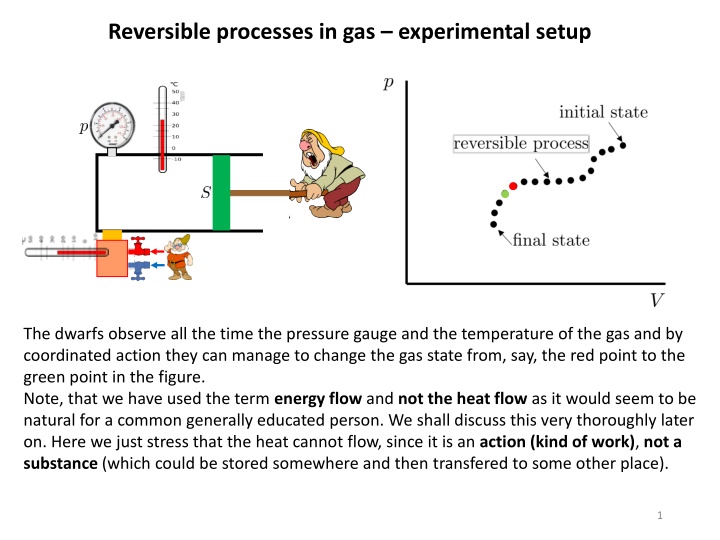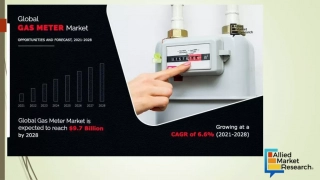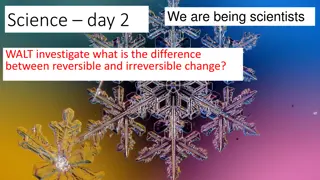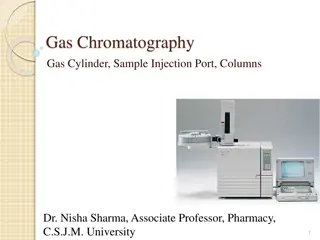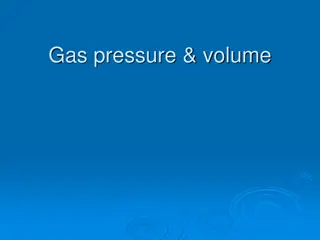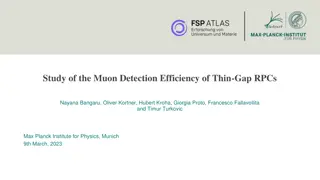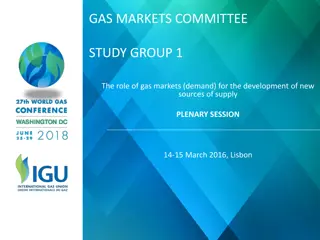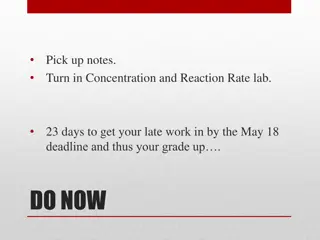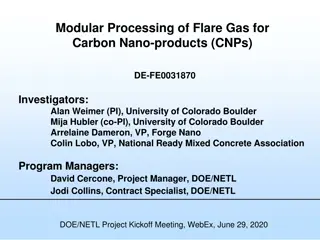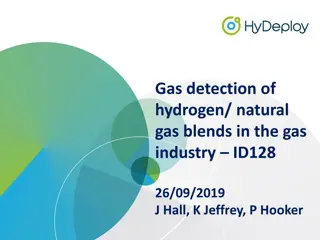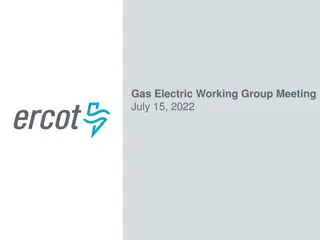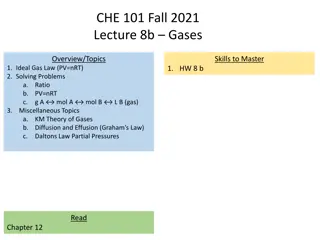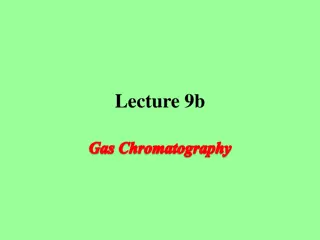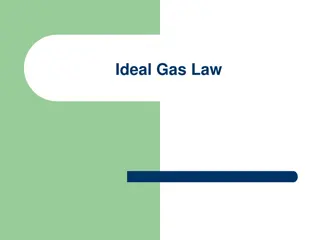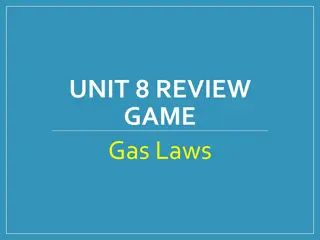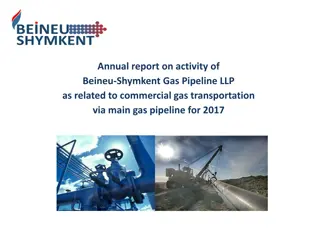Reversible Processes in Gas Experimental Setup
Reversible processes in gas experimental setup involving coordination between dwarfs to change the gas state from one point to another. Instructions for performing a reversible isothermal process and the concept of thought experiments are discussed, emphasizing the technique of thought experiment to check the viability of performing isothermal processes reversibly.
Download Presentation

Please find below an Image/Link to download the presentation.
The content on the website is provided AS IS for your information and personal use only. It may not be sold, licensed, or shared on other websites without obtaining consent from the author.If you encounter any issues during the download, it is possible that the publisher has removed the file from their server.
You are allowed to download the files provided on this website for personal or commercial use, subject to the condition that they are used lawfully. All files are the property of their respective owners.
The content on the website is provided AS IS for your information and personal use only. It may not be sold, licensed, or shared on other websites without obtaining consent from the author.
E N D
Presentation Transcript
Reversible processes in gas experimental setup The dwarfs observe all the time the pressure gauge and the temperature of the gas and by coordinated action they can manage to change the gas state from, say, the red point to the green point in the figure. Note, that we have used the term energy flow and not the heat flow as it would seem to be natural for a common generally educated person. We shall discuss this very thoroughly later on. Here we just stress that the heat cannot flow, since it is an action (kind of work), not a substance (which could be stored somewhere and then transfered to some other place). 1
Example: isothermal reversible process Let s discuss in detail the instructions for the piston pusher and boiler attendant to perform a reversible isothermal process. The task is to increase the volume . Instructions for the boiler attendant: Before starting the process prepare the temperature in your boiler to be equal to the gas temperature. During the process observe the gas thermometer. If, due to actions of the piston-pusher, the gas temperature starts to decrease, add hot water to the boiler so that the gas temperature would increase back to designed value due to energy transfer from boiler to the gas. If the gas temperature starts to increase, add some cold water to the boiler. What we have described in the form of instructions for the heat attendant is in technical praxis how a gadget called thermostat works. Instructions for the piston pusher: At the beginning push the piston by force ? = ?.? what just compensate the gas pressure thus keeping the piston at rest. Then decrease by a small amount your force what causes the piston to move to the right thus increasing the volume a little. Constantly watch the pressure gauge and maintain your pushing force just infinitesimally below the ?.? value thus enabling the piston to increase the volume continuously until the designed volume ?2is reached. 2
Thought experiments The previous, maybe a bit infantile, discussion wanted to demonstrate the technique of thought experiment . The purpose of doing thought experiments is to check consistency or consequences of some hypothesis, theory, intuitive formulation of ideas etc. In our case we wanted to check the viability of performing isothermal process reversibly. It could well happen that some briefly sketched idea like we perform a reversible isothermal process cannot be realized in reality. True realizations might be technically difficult due to technical engineering complications of non-principal character which could be overcome at least to an acceptable level. The thought experiment tries to check principal aspects of the idea by virtually doing an experiment free of technical complications. Einstein and Feynman were real masters of thought experiments. For a student a thought experiment can be a test do I really understand the lecture? Do the intellectual exercises like how would I experimentally test the theorem I am studying . Translating abstract notions into real world structures may discover, that you are, in fact, not fully understanding what you are speaking about. 3
Isothermal reversible process Having the experimental points we can try to find suitable formula (continuous curve) going through the points. We can do it by blind try-and-error method or we can use some more sophisticated computer program to fit the data . This is how the experimental points from the isothermal process might look. Phenomenologically, the isothermal process of an ideal gas satisfies the Boyle-Mariotte law: 4
Isotherms of ideal gas Boyle-Mariotte law is strictly valid only for ideal gas. On the ?? diagram of an ideal gas we can draw a system of isotherms for various temperatures like in the following figures for ?1< ?2< ?3< ?4< ?5< A point in the ?? diagram corresponds to an equilibrium macrostate. Seeing a point we can directly read the corresponding values of ?,?. B With the help of isotherm curves we can also read the corresponding temperature. We find the closest isotherms and then by interpolation we can find the temperature even with higher precision. For example, the red point in the figure divides the distance between the ?2,?3isotherms roughly as 2:1, so its temperature is roughly 5
Isobaric process This process is better visualized on a ?? diagram. Suppose we want reversibly change the state ?1?1to ?2?2, ?2> ?1, at constant pressure. Instructions for the boiler attendant: Starting with the boiler temperature ?1slowly add hot water to your boiler until you reach ?2. Do it slowly so that the piston-pusher be able to maintain constant pressure and the process be reversible. Instructions for the piston pusher: Keep watching the pressure gauge. If, due to actions of the boiler attendant, the gas pressure starts to increase, increase the volume so that the pressure drops back to required constant. If you overdo it and the pressure drops more, do decrease the volume a little. The piston-pusher works like a barostat (constant pressure- keeping device). The observation record in the ?? diagram might look like this: 6
Isobaric process A barostat function is technically easy to realize without any intelligent piston-pusher. One can use weight-loaded piston calculated so that the weight plus the atmospheric pressure add up to the desired pressure value. Gay-Lussac The experimental points can be fitted by a direct line (Gay-Lussac s law) This formula already respects the fact, that if we start the process with the initial volume doubled, the volume will be doubled through the whole process. Experimentally we would also find, that the coefficient ? (coefficient of volumetric thermal expansion) is independent of the pressure value and independent of the type of molecules provided the gas is ideal enough . 7
Isochoric process Isochoric process is experimentally quite difficult. One cannot jus fix the position of the piston: the container itself changes its dimensions with changing temperature. So the instructions for the piston-pusher are: constantly measure the container dimensions and keep adjusting the piston position so that the gas volume remains constant The experiment visualized on a pt diagram looks as follows Experimental points can be fitted as (Gay-Lussac law) Gay-Lussac The formula already respects the fact, that if we start the process with the initial pressure doubled, the pressure will be doubled through the whole process. Experimentally we would also find, that the coefficient ? (isochoric thermal pressure coefficient) is independent of the volume value and also independent of the type of molecules provided the gas is ideal enough , and, as we shall discuss shortly, its value for ideal gasses is the same as that of the coefficient of thermal expansion ?. 8
Adiabatic process Adiabatic process is a process performed on a thermally isolated gas. In the figure we see that the thermal coupling of the heating boiler to the gas was removed, so the boiler attendant is superfluous, he does not do anything. All the process is performed by the piston pusher. We shall postpone to write the equation of adiabatic curve on the ?? diagram for later discussion. No thermal contact here! But the piston pusher can arbitrarily change just one variable, the volume. He adjusts his pushing force according to the current gas pressure so that the process be reversible. Setting the volume to the desired value, he could read the final values of pressure and temperature. Empirically we find that during the adiabatic process (thermal isolation, no boiler attendant) final temperature would be different from the initial one. So the adiabatic process is different from isothermal process. To maintain a constant temperature we have to employ the boiler attendant to heat or cool the gas. The lesson of an adiabatic process (process in thermal isolation) is that one can change the temperature by performing just a macroscopic mechanical work. We shall come back to this observation when we shall speak about calorimetry. 9
Reversible processes in ideal gas, summary The following laws has been established for reversible processes in ideal gas Isothermal process Isobaric process Isochoric process The coefficient of isobaric thermal expansion ? and the coefficient of isochoric thermal pressure ? have the same value for an ideal gas and are universal, that is have the same value for all ideal gasses (provided we use the same value of the reference temperature ??). Their common value for ?0=0 C is The consequence of this universality is, that the extrapolated straight lines for isobaric and isochoric processes in ideal gasses intercept the temperature axis at a universal point at . Kelvin suggested to shift zero temperature to this point and leave the size of one degree the same as for Celsius scale. In this way the Kelvin temperature scale was defined. 10
New kelvin Later we abandoned the use of boiling point and freezing point of water as reference temperatures and the size of one Kelvin temperature difference was defined by defining the temperature of the triple point of water as 273.16K. So the connection to degree of Celsius was abandoned although practically the two degrees have equal size. The latest development is still different. Since 2019 SI system of units was redefined and was Kelvin defined anew: The kelvin is defined by fixing the numerical value of the Boltzmann constant k to 1.380 649 10 23J K 1 11
Equation of state Isobaric (Gay-Lussac) law has a very simple form when rewritten using absolute temperature in Kelvin. Freezing point of water in Kelvin is ?0= 273.15K and so ? can be written as ? = 1/?0. Guy-Lussac law will be or In a same way we can rewrite the isochoric Guy-Lussac law as Now we shall perform a compound process: starting at ?1,?1,?1we isothermally go to ?2,? ,?1and from there isobarically to ?2,?2,?2. Applying the corresponding laws we get and from there what is the ideal gas equation of state. 12
Equation of state Now recall the Avogadro s law: equal volumes of all gases, at the same temperature and pressure, have the same number of molecules. From there it is clear that the constant on in the last equation is proportional to the number of molecules and some universal constant The constant ? is called the Boltzmann constant: ? = 1.380649 10 23J/K The number of molecules ? can be easily expressed through the Avogadro number ??: and so the ideal gas equation of state reads Historically it used to be written using a different constant ? (so called gas constant) as ? = ??? =8.3144598 J mol 1 K 1 The reason was that the Avogadro number (and so neither the Boltzmann constant) was not known with acceptable precision, while ? can be measured easily. After the redefinition of mol by the new SI, the equation ? = ???/? is not exact, even though the error is experimentally negligible. The problem is not yet officially settled, if you want to know more, consult Wikipedia. 13
Work at reversible gas processes In thermodynamics and in statistical physics when we say work we have in mind macroscopically observable work related to our piston-pusher dwarf. The piston pusher (when manipulating the piston) has to use force to ensure, that the piston movement is slow enough for the process to be reversible. Applying force on a moving piston means that some work is performed. We stress, however, that there are two parties involved: the gas and the dwarf. In the same way as the dwarf acts on the gas by force the gas acts on the dwarf by force. These two forces are, by Newton s action-reaction principle, equal in size but opposite in direction. Therefore we can calculate two klinds of work. One which is performed by the dwarf on the gas, the other one which is performed by the gas on the dwarf. Speaking about a work, we have to specify whom we consider to be the performer of work and who is considered to be the receiver of the work . There are two possible choices: the dwarf as a performer and the gas as a receiver, or the dwarf as a receiver and the gas as a performer. Depending on our choice we get two different definitions of the work, differing by the sign. 14
Work at reversible gas processes Suppose we have chosen the gas to be the performer. The gas acts by a force from left to right. If the piston moves to the right by a distance ??, the gas performs the work Where ?? is the change of the gas volume. If we choose the dwarf to be the performer, he performs the work The standard choice in textbooks is gas as a performer so the standard formula used for work performed during the gas process is 15
Work at reversible gas processes Work performed during an infinitesimal reversible process in gas is Now consider a non-infinitesimal process from the state 1 to the state 2 as represented by the red path on the figure below. The total macroscopic work performed during that process would be The total work is obviously equal to the area below the curve representing the process. Now consider a different process between the same initial and final states, represented by the green curve. The area below the green curve is obviously different from the area below the red curve and therefore the total work performed along the green curve is different from that performed along the red curve. So the work depends on path, it is not a function of just the initial and finale states. 16
